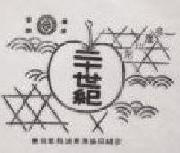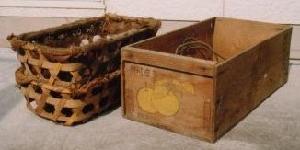Last updated: June 28, 2017
It is not clear when pear cultivation began in Inagi, as there are no old records, but legend has it that during the Genroku era, Masuoka Heiemon, the magistrate of Naganuma Village, started cultivating pears in Inagi. ) and Kawashima Sajiemon went on official business to Yamashiro no Kuni (southern part of Kyoto Prefecture), and on their way back they brought back pear seedlings called Awayuki. The log is said to have been in the front garden of the Kawashima family in Higashi-Naganuma until 1897, with a trunk circumference of 6 shaku (approximately 180 cm) and branches. It is said that it was a large tree measuring 30 tsubo (approximately 100 square meters).After that, pear cultivation gradually spread, and it is said that at the end of the Edo period, there were more than a dozen cultivators in the Naganuma and Yanoguchi villages.

pear wrapping paper

Pear shipping box and pear basket
Pear cultivation began in earnest after the Meiji period, and pear-growing cooperatives sprung up in various regions. In Higashi-Naganuma Village, 13 farmers established the ``Kyomeisha'' in 1889, which further developed into the ``Higashi-Naganuma Nashiyama Association'' in 1901. In Yanoguchi Village, the ``Yanoguchi Nashiyama Social Meeting'' was established in 1901. Together, they jointly purchased and shipped pear seedlings and fertilizer. In the latter half of the Meiji period, pear cultivation increased rapidly, and the main factor behind this was the introduction of a new variety, ``Chojuro'', in 1899.
Chojuro, a sweet pear grown in Taishigawara, Kawasaki, became widely cultivated as the mainstay of pear cultivation in Inagi. In addition, around 1903, a new variety called ``Nijuseiki'' was introduced, and as the area of pear cultivation in Inagi increased, the sales channels also expanded. In the latter half of the Meiji period, sales channels expanded from Hachioji to Ome in the west, Tokyo in the east, Tokorozawa in the north, and Yokohama in the south. The transformation of paddy fields into pear fields, which began in the middle of the Meiji era, continued into the Taisho era. In 1919, the Inagi Fruit Production Association was established, and progress was made to improve technology and expand sales channels. In 1932, pear producers along the Tama River united to form the Tamagawa Fruit Producers Association, and in 1930, the unified name ``Tamakawa Pear'' was also created. This period can be said to be the golden age of pear production. From the late 1940s onwards, pear gardens began to become tourist attractions, and street sales became popular. However, pear cultivation, which reached a peak in the 1960s, has been on a gradual decline since the 1960s.
| kinds | harvest time |
|---|---|
| longevity | Early August to mid-August |
| Tama | Early August to late August |
| Kosui | Late August to early September |
| New century | Late August to early September |
| Asahi | Late August to early September |
| Inagi | Late August to early September |
| Kiyotama | Late August to late September |
| Chojuro | Early September to late September |
| twentieth century | Early September to late September |
| Kikusui | Early September to late September |
| Excellence | Early September to mid-September |
| rich water | Mid-September to late September |
| Niitaka | late September to early October |
| new peace | Early October to mid-October |
| Yoshino | Early October to late October |
| Nova | Early October to late October |
| new snow | Late October to early November |
| Shuho | Late October to early November |
| emerging | Late October to early November |
| Atago | Late October to early November |
The four pear varieties, Inagi, Kiyotama, Shintaihei, and Yoshino, were born in Inagi.
Inagi City Education Department Lifelong Learning Division Tel: 042-377-2121